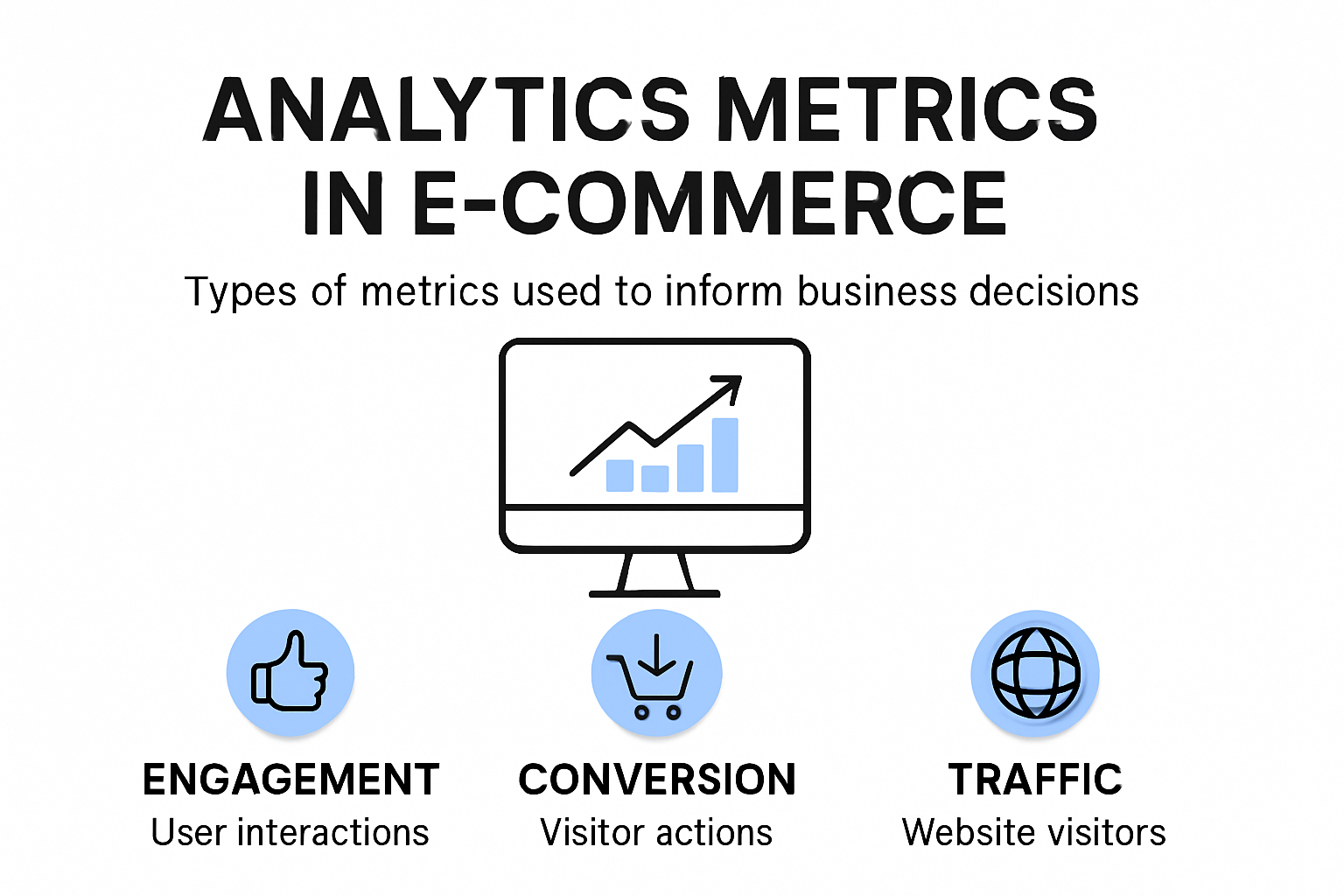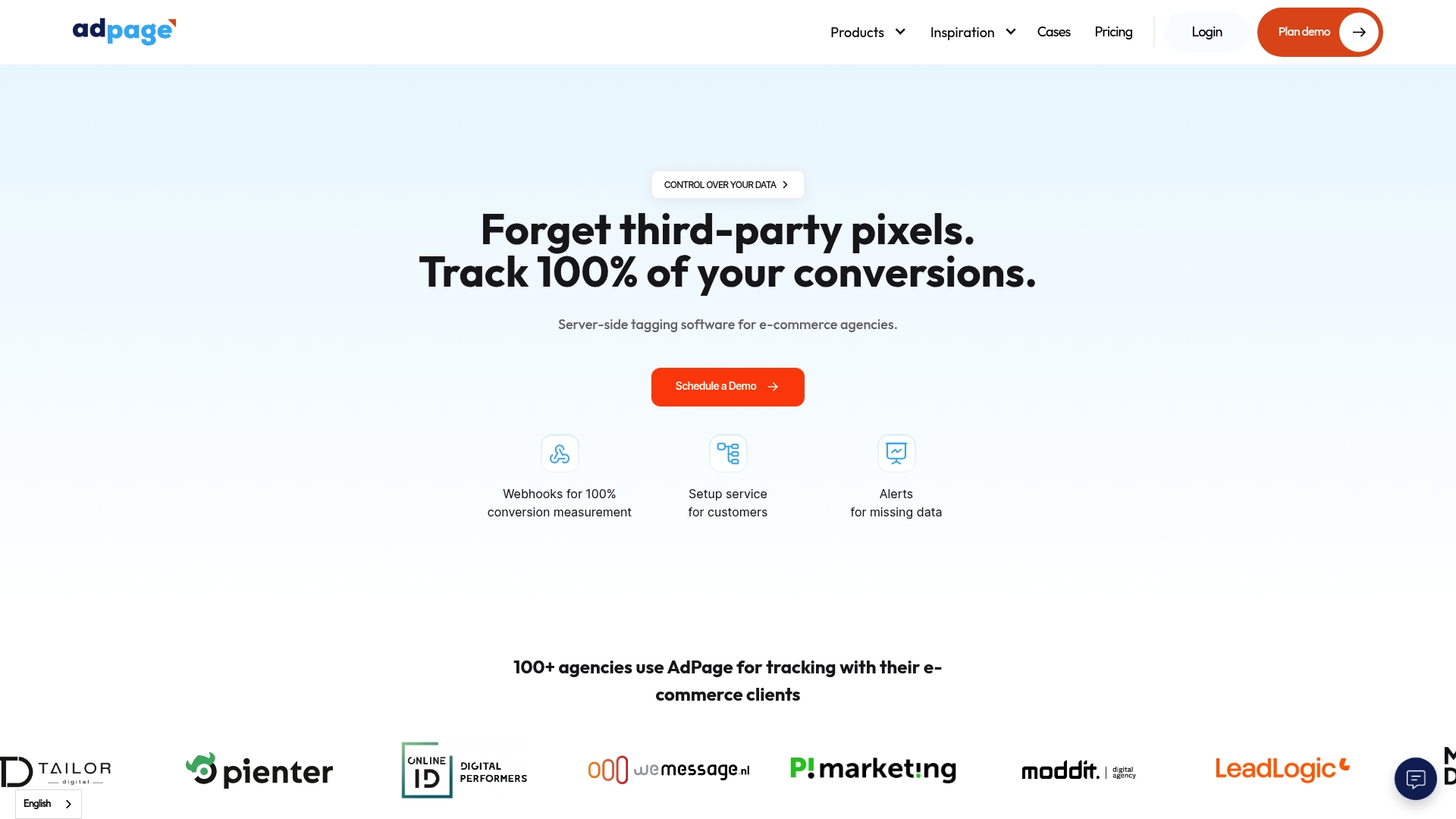Every click, scroll, and abandoned basket on your online shop leaves a trail of valuable clues. Yet despite all the data floating about, almost 70 percent of e-commerce businesses still make decisions based on gut instinct rather than solid analytics. That sounds high tech but surprisingly risky. The real winners are those who turn this digital noise into a crystal clear guide for strategic action.
Table of Contents
- What Are Analytics Metrics And Why They Matter
- Essential Metrics For E-Commerce And Digital Marketing
- How To Analyze Metrics For Better Conversion Rates
- Choosing The Right Tools For Detailed Analytics
Quick Summary
| Takeaway | Explanation |
|---|---|
| Analytics Metrics Drive Informed Decisions | Analytics metrics provide critical insights that help e-commerce businesses understand customer behavior and improve online performance through data-driven strategies. |
| Key Performance Indicators (KPIs) are Essential | KPIs like conversion rate and customer acquisition cost are vital for assessing business health and guiding strategic improvements in e-commerce operations. |
| Comprehensive User Journey Analysis Enhances Conversions. | Mapping the entire user journey and identifying friction points can reveal barriers to conversion, enabling targeted strategies for improvement. |
| Choosing the Right Tools is Crucial | Effective analytics tools should offer features like real-time reporting and data integration capabilities, ensuring businesses can act upon insights efficiently while maintaining data privacy. |
| Continuous Improvement Through Tactical Strategies | Implementing strategies such as A/B testing and conversion funnel optimization can incrementally enhance user experience and boost conversion rates. |
What Are Analytics Metrics and Why They Matter
Analytics metrics transform raw data into strategic insights that power intelligent decision making for e-commerce businesses. These numerical measurements provide a comprehensive view of online performance, enabling organizations to understand customer behavior, track progress, and make data-driven improvements.

Decoding the Essence of Analytics Metrics
Research from ResearchGate highlights that analytics metrics are far more than simple numbers. They represent a multi-dimensional approach to understanding digital performance. These metrics capture critical information across multiple dimensions including user engagement, conversion rates, traffic sources, and customer journey mapping.
In the context of e-commerce, analytics metrics serve as the fundamental language of business intelligence. They translate complex user interactions into actionable insights. By measuring specific parameters like page views, bounce rates, average session duration, and conversion funnels, businesses gain a nuanced understanding of their digital ecosystem.
Understanding Key Performance Indicators
Key performance indicators (KPIs) form the backbone of meaningful analytics metrics. These targeted measurements provide a clear snapshot of business health and strategic effectiveness. Web Analytics World suggests that effective KPIs should be:
- Specific: Precisely defined and unambiguous
- Measurable: Quantifiable with clear numerical representation
- Actionable: Providing insights that can drive strategic decisions
For e-commerce businesses, critical KPIs might include conversion rate, average order value, customer acquisition cost, and customer lifetime value. Each metric offers a unique lens through which to evaluate performance and identify opportunities for optimization.
The Strategic Importance of Analytics Metrics
Understanding analytics metrics transcends mere number crunching. These insights enable businesses to make informed, data-driven decisions that directly impact bottom line performance. By continuously monitoring and interpreting these metrics, organisations can:
- Identify potential bottlenecks in user experience
- Optimize marketing strategies
- Personalize customer interactions
- Allocate resources more efficiently
- Predict and anticipate market trends
The true power of analytics metrics lies in their ability to transform raw data into strategic intelligence. They provide a comprehensive view of digital performance, enabling businesses to move beyond guesswork and implement precision-driven strategies that deliver measurable results.
Essential Metrics for E-Commerce and Digital Marketing
Digital marketing and e-commerce success hinges on understanding and tracking the right performance metrics. These crucial indicators provide comprehensive insights into business growth, customer behavior, and marketing effectiveness.
Website Performance and Traffic Metrics
The U.S. Chamber of Commerce outlines critical website metrics that reveal how visitors interact with online platforms. Understanding these metrics enables businesses to optimize user experience and drive strategic improvements.
Key website performance metrics include:
- Sessions: Total number of user interactions within a specific timeframe
- Page Views: Number of individual pages visited
- Unique Page Views: Distinct page visits by individual users
- Traffic Sources: Origin of website visitors (organic search, social media, direct traffic)
- Bounce Rate: Percentage of users leaving the website after viewing a single page
These metrics help businesses understand user engagement, content effectiveness, and potential areas for website optimization.
To provide an at-a-glance summary of key website performance metrics, see the following table:
| Metric | Definition |
|---|---|
| Sessions | Total number of user interactions within a specific timeframe |
| Page Views | Number of individual pages visited |
| Unique Page Views | Distinct page visits by individual users |
| Traffic Sources | Origin of website visitors (organic, social media, direct, etc.) |
| Bounce Rate | Percentage of users leaving after viewing a single page |
Customer Acquisition and Conversion Metrics
Extensiv's comprehensive guide highlights critical e-commerce performance indicators that directly impact business growth. Customer acquisition and conversion metrics provide insights into marketing efficiency and revenue generation.
Critical metrics in this category include:
- Customer Acquisition Cost (CAC): Total expense of acquiring a new customer
- Conversion Rate: Percentage of visitors completing a desired action
- Average Order Value (AOV): Mean monetary value of individual customer transactions
- Email Marketing Click-Through Rate: Percentage of email recipients clicking embedded links
- Cost Per Acquisition (CPA): Marketing expense required to acquire a single customer

Advanced Customer Engagement Metrics
BigCommerce research reveals sophisticated metrics that provide deeper understanding of customer relationships and long-term business health.
Advanced engagement metrics andcompass:
- Customer Lifetime Value (CLV): Total revenue generated by a customer throughout their relationship
- Repeat Customer Rate: Percentage of customers making multiple purchases
- Net Promoter Score (NPS): Measurement of customer satisfaction and loyalty
- Churn Rate: Percentage of customers discontinuing business interactions
- Subscription Rate: Proportion of customers signing up for recurring services
By systematically tracking these metrics, e-commerce businesses can develop data-driven strategies, improve customer experiences, and drive sustainable growth. The key lies not just in collecting data, but in transforming these numerical insights into actionable intelligence that propels business performance forward.
To help compare and differentiate engagement metrics, the following table summarizes key advanced customer engagement metrics:
| Metric | What It Measures |
|---|---|
| Customer Lifetime Value | Total revenue generated by a customer over time |
| Repeat Customer Rate | Percentage of customers making multiple purchases |
| Net Promoter Score | Customer satisfaction and loyalty (likelihood to recommend). |
| Churn Rate | Percentage of customers who discontinue interactions |
| Subscription Rate | Percentage signing up for recurring services |
How to Analyze Metrics for Better Conversion Rates
Analyzing metrics for improved conversion rates requires a strategic approach that goes beyond simple data collection. It involves understanding complex user interactions, identifying potential barriers, and implementing targeted improvements that drive meaningful business results.
Comprehensive User Journey Analysis
Research from ArXiv emphasizes the critical importance of examining the entire user journey when analyzing conversion metrics. This comprehensive approach involves tracking user interactions across multiple touchpoints, identifying friction points, and understanding the nuanced factors that influence purchasing decisions.
Key aspects of user journey analysis include:
- Interaction Mapping: Tracking user movements through the website
- Funnel Visualization: Identifying where potential customers drop off
- Device and Browser Performance: Ensuring consistent experience across platforms
- User Behaviour Segmentation: Understanding different user group patterns
By meticulously examining these elements, businesses can uncover hidden obstacles that prevent potential customers from completing their purchase.
Predictive Analytics and Conversion Optimization
Research from ResearchGate reveals how machine learning algorithms can transform metric analysis. Predictive analytics enables businesses to anticipate customer behavior, personalize user experiences, and proactively address potential conversion barriers.
Effective predictive strategies involve:
- Behavioural Prediction Models: Forecasting likely customer actions
- Personalization Algorithms: Tailoring user experiences.
- Risk and Opportunity Identification: Detecting potential conversion challenges
- Dynamic Pricing Strategies: Optimizing pricing based on user insights
Tactical Metric Improvement Strategies.
NetSuite's comprehensive guide outlines practical approaches for converting metric insights into actionable improvements. The goal is to transform data analysis into tangible strategies that directly impact conversion rates.
Practical improvement tactics include:
- Continuous A/B Testing: Experimenting with different design and content elements
- Conversion Funnel Optimization: Streamlining user pathways
- Performance Benchmarking: Comparing metrics against industry standards
- Targeted User Experience Enhancements: Addressing specific friction points
Successful conversion rate optimization is not about making massive changes, but implementing precise, data-driven adjustments that incrementally improve user experience and purchasing likelihood. By combining comprehensive analysis, predictive insights, and tactical improvements, businesses can create a robust strategy for enhancing their e-commerce performance.
Choosing the Right Tools for Detailed Analytics
Selecting appropriate analytics tools is crucial for transforming raw data into strategic business intelligence. The right analytical platform can provide comprehensive insights, enabling businesses to make informed decisions and drive meaningful performance improvements.
Essential Features of Effective Analytics Tools
Tableau's white paper highlights the critical importance of creating informative and interactive dashboards that consolidate complex data into comprehensible views. When evaluating analytics tools, businesses should consider several fundamental features:
- Data Integration Capabilities: Ability to combine data from multiple sources seamlessly
- Real-Time Reporting: Instant access to current performance metrics
- Customizable Dashboards: Flexible visualization options
- Advanced Segmentation: Detailed audience and performance breakdown
- User-Friendly Interface: Intuitive design enabling easy navigation
These features ensure that businesses can quickly understand and act upon their digital performance data without requiring extensive technical expertise.
Privacy and Compliance Considerations
EDUCBA's comprehensive analysis emphasizes the critical importance of selecting tools that prioritize data privacy and regulatory compliance. Modern analytics platforms must provide robust mechanisms for protecting user information while delivering actionable insights.
Key compliance considerations include:
- GDPR Compatibility: Ensuring European data protection standards
- CCPA Adherence: Meeting California consumer privacy regulations
- Data Anonymization: Protecting individual user identities
- Consent Management: Transparent user data collection practices.
- Secure Data Storage: Implementing advanced encryption protocols
Businesses must prioritize tools that not only provide powerful analytics but also maintain stringent data protection standards.
Strategic Tool Selection Methodology
Choosing the right analytics tool requires a systematic approach that goes beyond surface-level features. Organizations should develop a comprehensive evaluation framework that considers:
- Business Specific Requirements: Alignment with unique organizational needs
- Scalability: Capacity to grow alongside business operations
- Integration Potential: Compatibility with existing technology infrastructure
- Cost Effectiveness: Balanced investment against potential insights
- Support and Training: Vendor provided implementation assistance
Successful analytics tool selection is not about finding the most expensive or feature-rich platform, but identifying a solution that seamlessly integrates with existing workflows and provides clear, actionable insights. By carefully assessing tools against these multifaceted criteria, businesses can develop a robust analytics strategy that transforms data into competitive advantage.
Frequently Asked Questions
What are analytics metrics in e-commerce?
Analytics metrics in e-commerce are numerical measurements that provide insights into online performance, user behavior, and customer interactions. They help businesses understand their digital ecosystem and make informed, data-driven decisions.
Why are key performance indicators (KPIs) important for e-commerce?
KPIs are essential for e-commerce as they provide measurable insights into business health, guiding strategic improvements. Metrics like conversion rate, customer acquisition cost, and average order value help assess performance and identify optimization opportunities.
How can I improve conversion rates using analytics?
Improving conversion rates involves comprehensive user journey analysis, identifying friction points, and implementing data-driven strategies such as A/B testing, conversion funnel optimization, and personalizing customer experiences based on predictive analytics.
What features should I look for in e-commerce analytics tools?
When selecting e-commerce analytics tools, consider features such as data integration capabilities, real-time reporting, customizable dashboards, advanced segmentation, and a user-friendly interface to ensure effective data analysis and insights.
Precision Tracking for E-Commerce Success Starts Here
Are you struggling with blind spots in your e-commerce analytics, even after pouring over bounce rates and conversion funnels? The article has shown how making decisions without complete and accurate data can hold your business back. Many online stores lose vital insights due to ad blockers, browser restrictions or outdated analytics methods. This can make it impossible to trust your numbers and create winning strategies.

It's time to take control of your e-commerce results. With AdPage, you can empower your team to monitor 100 percent of conversions, remove data loss from third-party tracking, and unlock server-side tagging for unbeatable accuracy. Benefit from seamless integration with leading e-commerce platforms, advanced consent management, and full GDPR compliance. If you want to move beyond guesswork and ensure every conversion is captured, visit our platform now and turn your analytics metrics into real growth. Start today to optimize your tracking before you miss another sale.



.png)
